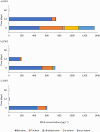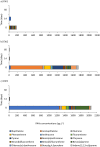Constructed wetland as a green remediation technology for the treatment of wastewater from underground coal gasification process
- PMID: 38470886
- PMCID: PMC10931533
- DOI: 10.1371/journal.pone.0300485
Constructed wetland as a green remediation technology for the treatment of wastewater from underground coal gasification process
Abstract
The wastewater from underground coal gasification (UCG) process has extremely complex composition and high concentrations of toxic and refractory compounds including phenolics, aliphatic and aromatic hydrocarbons, ammonia, cyanides, hazardous metals and metalloids. So, the development of biological processes for treating UCG wastewater poses a serious challenge in the sustainable coal industry. The aim of the study was to develop an innovative and efficient wetland construction technology suitable for a treatment of UCG wastewater using available and low-cost media. During the bioremediation process the toxicity of the raw wastewater decreased significantly between 74%-99%. The toxicity units (TU) ranged from values corresponding to very high acute toxic for raw wastewater to non-toxic for effluents from wetland columns after 60 days of the experiment. The toxicity results correlated with the decrease of some organic and inorganic compounds such as phenols, aromatic hydrocarbons, cyanides, metals and ammonia observed during the bioremediation process. The removal percentage of organic compounds like BTEX, PAHs and phenol was around 99% just after 14 days of treatment. A similar removal rate was indicated for cyanide and metals (Zn, Cr, Cd and Pb). Concluded, in order to effectively assess remediation technologies, it is desirable to consider combination of physicochemical parameters with ecotoxicity measurements. The present findings show that wetland remediation technology can be used to clean-up the heavily contaminated waters from the UCG process. Wetland technology as a nature-based solution has the potential to turn coal gasification wastewater into usable recycled water. It is economically and environmentally alternative treatment method.
Copyright: © 2024 Jałowiecki et al. This is an open access article distributed under the terms of the Creative Commons Attribution License, which permits unrestricted use, distribution, and reproduction in any medium, provided the original author and source are credited.
Conflict of interest statement
The authors have declared that no competing interests exist.
Figures





Similar articles
-
A hybrid system based on the combination of adsorption, electrocoagulation, and wetland treatment for the effective remediation of industrial wastewater from underground coal gasification (UCG).J Environ Manage. 2024 Dec;371:123180. doi: 10.1016/j.jenvman.2024.123180. Epub 2024 Nov 6. J Environ Manage. 2024. PMID: 39509979
-
Chemical and toxicological evaluation of underground coal gasification (UCG) effluents. The coal rank effect.Ecotoxicol Environ Saf. 2015 Feb;112:105-13. doi: 10.1016/j.ecoenv.2014.10.038. Epub 2014 Nov 12. Ecotoxicol Environ Saf. 2015. PMID: 25463860
-
Chemometric Study of the Ex Situ Underground Coal Gasification Wastewater Experimental Data.Water Air Soil Pollut. 2012 Nov;223(9):5745-5758. doi: 10.1007/s11270-012-1311-5. Epub 2012 Sep 22. Water Air Soil Pollut. 2012. PMID: 23136453 Free PMC article.
-
State of the art of biological processes for coal gasification wastewater treatment.Biotechnol Adv. 2016 Sep-Oct;34(5):1064-1072. doi: 10.1016/j.biotechadv.2016.06.005. Epub 2016 Jun 27. Biotechnol Adv. 2016. PMID: 27364381 Review.
-
Treatment of electroplating industry wastewater: a review on the various techniques.Environ Sci Pollut Res Int. 2022 Oct;29(48):72196-72246. doi: 10.1007/s11356-022-18643-y. Epub 2022 Jan 27. Environ Sci Pollut Res Int. 2022. PMID: 35084684 Review.
References
-
- Pankiewicz-Sperka M, Kapusta K, Basa W, Stolecka K. Characteristics of Water Contaminants from Underground Coal Gasification (UCG) Process—Effect of Coal Properties and Gasification Pressure. Energies. 2021; 14, 6533. doi: 10.3390/en14206533 - DOI
-
- Liu SQ, Li JG Mei M, Dong DL. Groundwater pollution from underground coal gasification. J China Univ Mining Technol. 2007; 17, 467–472. doi: 10.1016/S1006-1266(07)60127-8 - DOI
-
- Kapusta K, Stańczyk K, Wiatowski M, Chećko J. Environmental aspects of a field-scale underground coal gasification trial in a shallow coal seam at the Experimental Mine “Barbara” in Poland. Fuel. 2013; 113, 196–208. doi: 10.1016/j.fuel.2013.05.015 - DOI
-
- Kwiecińska A, Lajnert R, Bigda R. Coke oven wastewater—formation, treatment and utilization methods—A review. Proceedings of ECOpole. 2017; 11. doi: 10.2429/proc.2017.11(1)002 - DOI
MeSH terms
Substances
LinkOut - more resources
Full Text Sources

